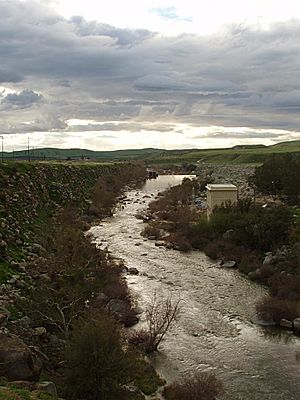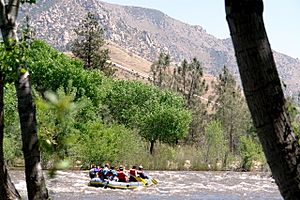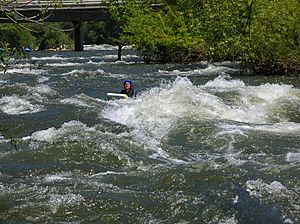Kern River facts for kids
Quick facts for kids Kern River |
|
|---|---|

Panorama of the upper Kern River
|
|

Map of the San Joaquin and Tulare Basin region with the Kern River highlighted. Some rivers shown are intermittent or normally dry. A few selected canals are shown. Below: Map of the San Joaquin and Tulare Basin region showing the old lakes and river courses.
|
|
| Other name(s) | Rio de San Felipe, La Porciuncula, Po-sun-co-la, Porsiuncula River |
| Country | United States |
| State | California |
| Region | Sierra Nevada, San Joaquin Valley |
| District | Tulare County, Kern County |
| City | Bakersfield |
| Physical characteristics | |
| Main source | Kings-Kern Divide Sequoia National Park 13,608 ft (4,148 m) 36°41′48″N 118°23′53″W / 36.69667°N 118.39806°W |
| River mouth | Buena Vista Lake Bed San Joaquin Valley 299 ft (91 m) 35°16′4″N 119°18′25″W / 35.26778°N 119.30694°W |
| Length | 164 mi (264 km) |
| Basin features | |
| Basin size | 3,612 sq mi (9,360 km2) |
| Type: | Wild, Scenic, Recreational |
| Designated: | November 24, 1987 |
The Kern River, originally Rio de San Felipe, later La Porciuncula, is a river in the U.S. state of California, approximately 165 miles (270 km) long. It drains an area of the southern Sierra Nevada mountains northeast of Bakersfield. Fed by snowmelt near Mount Whitney, the river passes through scenic canyons in the mountains and is a popular destination for whitewater rafting and kayaking. It is the southernmost major river system in the Sierra Nevada, and is the only major river in the Sierra that drains in a southerly direction.
The Kern River formerly emptied into the now dry Buena Vista Lake and Kern Lake via the Kern River Slough, and Kern Lake in turn emptied into Buena Vista Lake via the Connecting Slough at the southern end of the Central Valley. Buena Vista Lake, when overflowing, first backed up into Kern Lake and then upon rising higher drained into Tulare Lake via Buena Vista Slough and a changing series of sloughs of the Kern River. The lakes were part of a partially endorheic basin that sometimes overflowed into the San Joaquin River. This basin also included the Kaweah and Tule Rivers, as well as southern distributaries of the Kings River that all flowed into Tulare Lake.
Since the late 19th century the Kern has been almost entirely diverted for irrigation, recharging aquifers, and the California Aqueduct, although some water empties into Lake Webb and Lake Evans, two small lakes in a portion of the former Buena Vista Lakebed. The lakes were created in 1973 for recreational use. The lakes hold 6,800 acre⋅ft (8,400 dam3) combined. Crops are grown in the rest of the former lakebed. In extremely wet years the river will reach the Tulare Lake basin through a series of sloughs and flood channels.
Despite its remote source, nearly all of the river is publicly accessible. The Kern River is particularly popular for wilderness hiking and whitewater rafting. The Upper Kern River is paralleled by trails to within a half-mile of its source (which lies at 13,600 feet (4,100 m)). Even with the presence of Lake Isabella, the river is perennial down to the lower Tulare Basin. Its swift flow at low elevation makes the river below the reservoir an extremely popular location for rafting.
Course
The Kern begins in the Sierra Nevada in Sequoia National Park in northeastern Tulare County, near the border with Inyo County. The main branch of the river (sometimes called the North Fork Kern River) rises from several small lakes in a basin northwest of Mount Whitney. The headwaters are surrounded by the Great Western Divide to the west, the Kings-Kern Divide to the north and the main Sierra Crest to the east, all of which have multiple peaks above 13,000 feet (4,000 m). The Kern River flows due south through a deep glacier-carved valley, passing through Inyo and Sequoia National Forests and the Golden Trout Wilderness, and receiving numerous tributaries including Rock Creek, Big Arroyo, Golden Trout Creek and Rattlesnake Creek. After deviating briefly from its due south course as it flows east around Hockett Peak, it is joined by the Little Kern River from the northwest at a site called Forks of the Kern. Below there, the Kern River continues south, and is joined by more tributaries including Peppermint Creek, South Creek, Brush Creek, and Salmon Creek, which all form large waterfalls as they tumble into the Kern River canyon.
At Kernville the river emerges from its narrow canyon into a wide valley where it is impounded in Lake Isabella, formed by Isabella Dam. The area was once known as Whiskey Flat, the former location of the town of Kernville. In Lake Isabella, it is joined by its largest tributary, the South Fork Kern River, which drains a high plateau area to the east of the North Fork drainage. The 95-mile (153 km)-long South Fork rises in Tulare County and flows south through Inyo National Forest, turning west after entering Kern County.
Below Isabella Dam the Kern River flows southwest in a rugged canyon along the south edge of the Greenhorn Mountains, parallel to SR 178. A number of hot springs are located along this section of the river. With a descent of 2,000 feet (610 m) between Isabella Dam and Bakersfield, this section of the Kern River feeds several hydroelectric plants and is also a popular whitewater run. Due to upstream dam releases for irrigation and power generation, this part of the river has a swift flow even in the driest summers. The river then flows through a winding valley in the Sierra foothills before entering the San Joaquin Valley at Bakersfield, the largest city on the river. In Bakersfield proper, most of the river's flow is diverted into various canals for agricultural use in the southern San Joaquin Valley, and provide municipal water supplies to the City of Bakersfield and surrounding areas. This fertile region is a large alluvial plain, or inland delta, formed by the Kern River, which once spread out into vast wetlands and seasonal lakes.
The Friant-Kern Canal, constructed as part of the Central Valley Project, joins the Kern about 4 mi (6.4 km) west of downtown Bakersfield, restoring some flow to the river. The river channel continues about 20 miles (32 km) southwest to a point near the California Aqueduct on the western side of the San Joaquin Valley. A weir allows excess floodwaters from the Kern to drain into the California Aqueduct, while any remaining water continues south into the seasonal Buena Vista Lake, which once reached sizes of about 4,000 acres (1,600 ha) in wet periods. Historically, a 20 mi (32 km) distributary of the Kern split off above Bakersfield and flowed south to what is now Arvin, where it formed the seasonal Kern Lake, which would grow to cover about 8,300 acres (3,400 ha) during wet periods. Water from Kern Lake would then flow west through Buena Vista Slough into Buena Vista Lake.
In periods of extremely high runoff, Buena Vista Lake overflowed and joined other wetlands and seasonal lakes in a series of sloughs that drained north into the former Tulare Lake, which would sometimes overflow into the San Joaquin River via Fresno Slough.
The Kern River is one of the very few rivers in the Central Valley which does not contribute water to the Central Valley Project (CVP). However, water from the CVP, mainly the Friant-Kern Canal, will be deposited for water storage in the aquifers.
History
The river was named by John C. Frémont in honor of Edward M. Kern in 1845 who, as the story goes, nearly drowned in the turbulent waters. Kern was the topographer of Fremont's third expedition through the American West. Before this, the Kern River was known as the "Rio de San Felipe" as named by Spanish missionary explorer Fr. Francisco Garcés when he explored the Bakersfield area on May 1, 1776. On August 2, 1806, Padre Zavidea renamed the river La Porciuncula for the day of the Porciuncula Indulgence. It was locally known as Po-sun-co-la until its renaming by Fremont.
Gold was discovered along the upper river in 1853. The snowmelt that fed the river resulted in periodic torrential flooding in Bakersfield until the construction of the Isabella Dam in the 1950s. These floods would periodically change the channel of the river. Since the establishment of Kern County in 1866 the main channel has flowed through what is the main part of downtown Bakersfield along Truxtun Avenue and again made a south turn along what is Old River Road. Many of the irrigation canals that flow in a southerly direction from the river follow the old channels of the Kern River, especially the canal that flows along Old River Road. The irrigated region of the Central Valley near the river supports the cultivation of alfalfa, carrots, fruit, and cotton, cattle grazing, and many other year-round crops. In 1987 the United States Congress designated 151 miles (243 km) of the Kern's North (Main) Fork and South Fork as a National Wild and Scenic River.
The Great 1857 Fort Tejon earthquake on January 9, 1857 with an estimated magnitude of 7.9 on the San Andreas Fault was strong enough to temporarily switch the direction of the flow of the Kern River. Fish in the now dry Tulare Lake were left stranded on the shores.
The Buena Vista Lake basin is an arid area and the Kern River is the only significant water supply. Ongoing conflicts between urban and agricultural interests complicate management decisions, in recent years owing to the expiration of some long-term contractual agreements.
Exacerbating the problem, ongoing dam safety problems at Isabella Dam have led to reduced water storage there while repairs are made.
Ecology
The Kern River watershed is the native range of California's State Freshwater Fish, California golden trout (Oncorhynchus mykiss aguabonita), which are native to the Kern River tributaries South Fork Kern River and Golden Trout Creek, and the latter's tributary, Volcano Creek. Two currently recognized and closely related sibling subspecies. The Little Kern golden trout (O. m. whitei), found in the Little Kern River basin, and the Kern River rainbow trout (O. m. gilberti), are also found in the Kern River system. Together, these three trout form what is sometimes referred to as the "Golden Trout Complex".
In 2008, after public outcry, the City of Bakersfield and the California Department of Fish and Game (CDFG) decided to relocate a family of California Golden beaver (Castor canadensis subauratus) instead of killing them. California Golden beaver were native to the Central Valley and throughout the Sierra Nevada. Specifically to the Kern watershed, an oral history was taken from Roy De Voe, who claimed to have seen "very old beaver sign" on the east side of the Kern River at Funston Meadow (elevation 6,476 feet (1,974 m)) in 1946. Also, Mr. De Voe reported that his friend Kenny Keelor trapped the Kern River for beaver around 1900, making his camp at the mouth of Rattlesnake Creek (elevation 6,585 feet (2,007 m)) until they were trapped out completely by 1910 – 1914. The presence of Beaver Canyon Creek, tributary to the lower Kern River just east of Delonegha Hot Springs, is also consistent with the Kern River watershed having historically supported native beaver. This oral history is consistent with another oral history taken one watershed to the north by CDFG's Donald T. Tappe from a retired game warden in 1940, who stated that beaver were "apparently not uncommon on the upper part of the Kings River" until 1882–1883. Currently, there are large numbers of beaver in the Ramshaw Meadows on the South Fork Kern River where their dams are trapping sediment, forming extensive pools, accelerating meadow restoration, and increasing riparian willow habitat.
Geology

The upper Kern River Canyon was created primarily as a result of tectonic forces, and not just by the erosional force of the river. The geologically active Kern Canyon Fault runs the length of the canyon, from the river's headwaters down to the Walker Basin about 10 miles (16 km) south of Lake Isabella. The river's course has been modified several times throughout ancient geological history. Prior to 10 million years ago, the Kern River flowed into the San Joaquin Valley at a point further south, along what is now Walker Basin Creek, which outlets north of Arvin. Uplift west of the Kern Canyon Fault blocked the river and forced it to cut a new course further north, forming the steep gorge below Lake Isabella and Bakersfield. The upper part of the Kern River canyon, at least above Golden Trout Creek, was widened and deepened by glaciers during the Ice Ages. The Kern Canyon fault passes very close to Isabella Dam, and is considered a threat to the dam's structural stability.
The Kern River Oil Field is adjacent to the river on the north, just before the river flows into Bakersfield. The large oil field, on low hills which rise gradually into the Sierra foothills, formerly allowed much of its wastewater to drain directly south into the river. However, modern environmental regulation ended this practice, and the contaminated water is now cleaned at water treatment plants and used to irrigate farms in the valley to the west.
Discharge
Due to water diversion and Isabella Dam the Kern River's discharge changes considerably over its length. The highest mean annual flows occur just downriver of Isabella Dam, but because the dam serves to regulate the flow of water the highest daily discharges occur above the dam on the North Fork section of the Kern River. The USGS stream gauge on the North Fork Kern River has recorded an average annual mean discharge of 806 cubic feet per second (23 m3/s) and a maximum daily discharge of 33,600 cu ft/s (950 m3/s), and the gauge on the South Fork Kern River shows an average annual mean discharge of 123 cu ft/s (3.5 m3/s) and a maximum daily discharge of 14,000 cu ft/s (400 m3/s). In contrast the first stream gauge below Isabella Dam has recorded an average annual mean of 946 cu ft/s (27 m3/s) but a maximum daily discharge of only 7,030 cu ft/s (200 m3/s). Due to water withdrawals the three stream gauge stations below Isabella Dam show a dramatically decreasing discharge. At the last gauge, near Bakersfield, the river's average flow is only 312 cu ft/s (8.8 m3/s).
Recreation
Kern Canyon, the deep canyon of the river northeast of Bakersfield, is a popular location for fishing and boating, particularly fly fishing and whitewater rafting, whitewater kayaking, and riverboarding. Of particular interest to fishermen are the Kern River rainbow trout, the Little Kern golden trout, and the California golden trout. The Kern Canyon is popular for camping, hiking, and picnicking. There are developed campgrounds maintained by the US Forest Service along the North Fork of the Kern River. Campgrounds include Camp 3, Fairview, Goldledge, Headquarters, Hospital Flat, and Limestone. All of the campgrounds are open in the summer months while only a few remain open year-round.
The Kern is well known for its danger, and is sometimes referred to as the "killer Kern". A sign at the mouth of Kern Canyon warns visitors: "Danger. Stay Out. Stay Alive" and tallies the deaths since 1968; as of May 22, 2020, the number of deaths listed is 307. Merle Haggard's song "Kern River" fictionally recounts such a tragedy. Haggard's last song, "Kern River Blues", was recorded two months prior to his death in 2016.
Below the canyon the Kern River has a gradient of 0.3% until it reaches the Kern River Oil Field and begins to meander along flat land into and through the city of Bakersfield. Tubing is popular along this stretch.
The Class II whitewater located in Kernville is used for the slalom event of the annual Kern River Festival.
Images for kids
See also
 In Spanish: Río Kern para niños
In Spanish: Río Kern para niños





